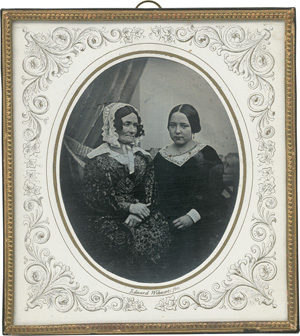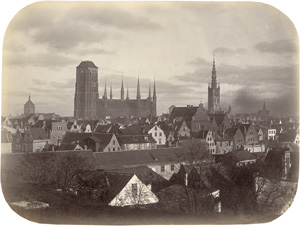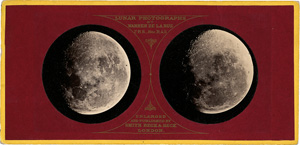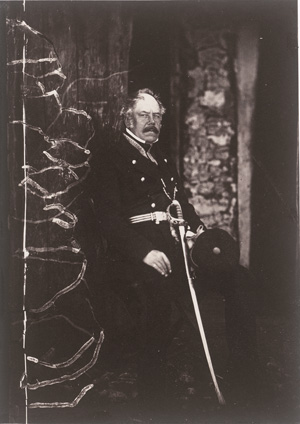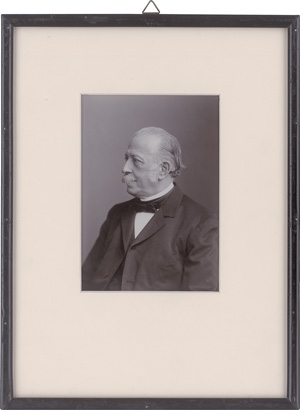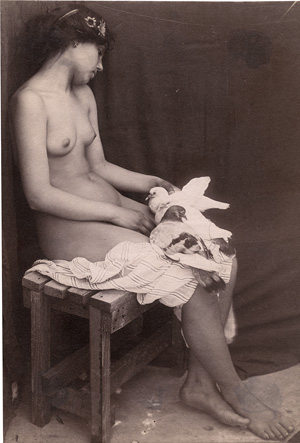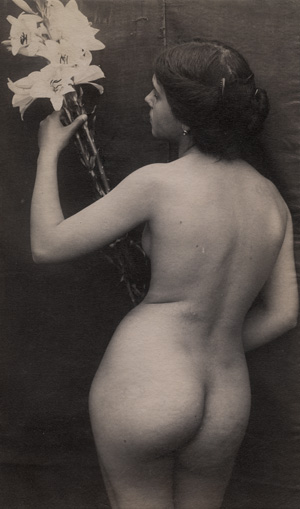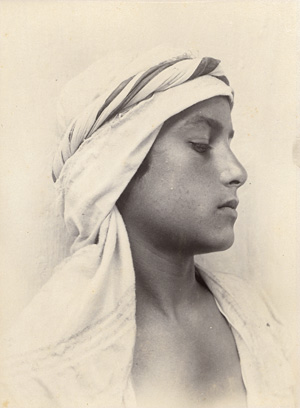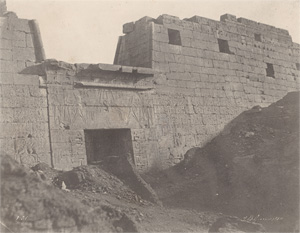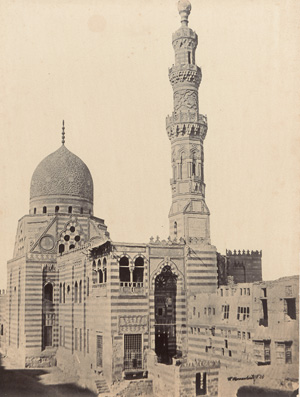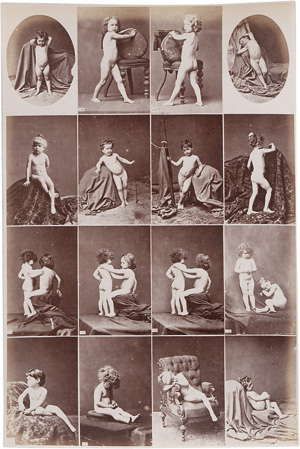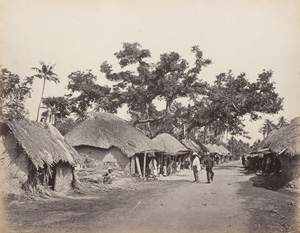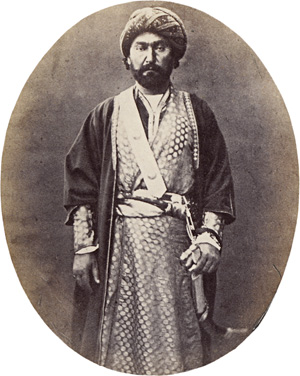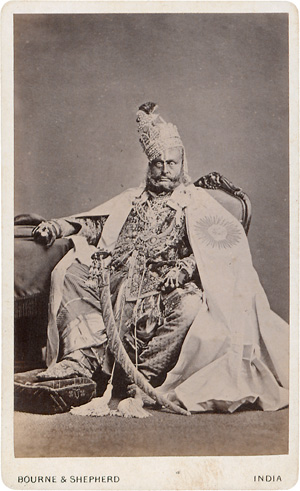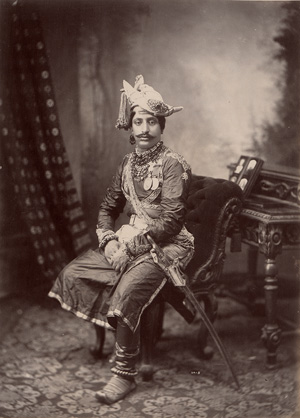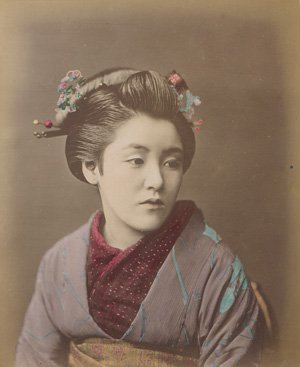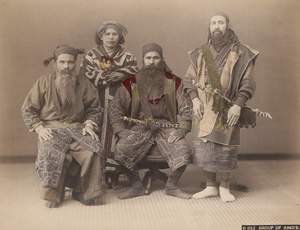Photographer: Eduard Wehnert (1811-1847). Portrait of a mother with her daughter. Circa 1844. Quarter-plate daguerreotype (plate size circa 10 x 8 cm). With original gilt-highlighted ornamental paper surround with photographer's printed name, taped behind glass with gilt paper band.
In 1845, Eduard Wehnert married Bertha Wehnert-Beckmann, widely recognized as the first professional female photographer in Germany. Active in the early 1840s, she played a pioneering role in the history of photography. Daguerreotypes by Eduard Wehnert himself are exceedingly rare, and seldom appear on the market. – Some oxidation spots, otherwise in good condition.
Photographer: A. Ballerstaedt (active ca. 1865-1880). Views of Danzig. Ca. 1870s. 21 albumen prints, mounted to card. Each between 16 x 22 cm and 19 x 24 cm or reverse (28 x 37 cm). All with photographer’s blind stamp in lower margin: “A. Ballerstaedt / Danzig / Photograph. Atelier”; annotated in pencil on lower margin of recto as well as in black ink on verso in a contemporary hand.
A striking visual record of late 19th-century Danzig (now Gdańsk), this group includes views of significant civic and architectural landmarks of the historic Hanseatic city. Depicted are the Artus Court (Artushof), the Golden Gate (Langgasser Tor), the Great Armory (Großes Zeughaus), the Green Gate (Grünes Tor), the Old City Hall, and the Marienkirche from various perspectives, including panoramic views of the historic center. Many views are animated with horse-drawn carriages and passersby, offering a glimpse of urban life in the Prussian-era city. The photographs, distinguished by sharp detail and balanced compositions, reflect Ballerstadt’s skill in capturing both architectural grandeur and atmospheric cityscapes. – Minimal foxing on the mounts; some light fading on a few prints. Otherwise, all prints with strong tones and in near excellent condition.
Davey, Frank
Hawaiians eating a meal; Two Hawaiians with their boats, Diamond Head Beach, Oahu
Los 4033
Schätzung
600€ (US$ 667)
Hawaiins eating a meal; Two Hawaiians with their boats, Diamond Head Beach, Oahu. 1890s. 2 albumen prints. 18,2 x 23,7 cm. Each with number and caption in the negative in lower edge, each mounted to board.
London-born Frank Davey was a prolific photographer active in London, Paris, and later California. After leaving England in 1880, he eventually settled in Hawaii around 1897-1901, where he photographed Indigenous communities, island landscapes, and early surf culture. He is considered one of the first photographers to document surfing. – A few light surface scuff marks, otherwise in very good condition.
Lunar photographs. 1858-1859. 7 stereoscopic albumen prints, mounted on red mounts with yellow card stock. Each ca. 8,5 x 17,5 cm. Printed captions on recto with photographer credit and publisher imprint “Enlarged and published by Smith, Beck & Beck” or “Charles Panknin, London”; versos with printed explanatory text on some cards, including series number, date of negative, and in some cases, age of the moon and libration in longitude and latitude.
These remarkable stereoscopic lunar photographs stem from one of the most ambitious scientific imaging projects of the 19th century. Between 1858-1862, British astronomer Warren De La Rue - working at the Kew Observatory - used a custom-designed photoheliograph to capture detailed wet collodion negatives of the moon’s surface. The stereoscopic prints, produced by pairing negatives taken under different libration conditions, created a three-dimensional illusion of lunar topography when viewed through a stereoscope. Issued by leading scientific publishers such as Smith, Beck & Beck and Charles Panknin, the views were intended to make cutting-edge astronomical research accessible to both scientific and lay audiences. These photographs mark a seminal moment in the history of celestial observation and the broader popularization of scientific imagery in Victorian Britain. – Some light scuff marks on some prints and edge wear on mounts, otherwise all in very good condition with strong tonal range.
Delamotte, Philip Henry
The Crystal Palace at Sydenham
Los 4035
Schätzung
1.000€ (US$ 1,111)
The Crystal Palace at Sydenham. 1854. 3 albumen prints, printed early 1860s. 23,7 x 29 cm, 23 x 28 cm and 16,2 x 19,5 cm. Annotated in pencil on the verso.
This group comprises compelling views of the Crystal Palace at Sydenham shortly after its completion, including exterior views and an interior view featuring John Bell’s allegorical sculpture Una and the Lion, exhibited within the Palace’s grand halls.
– Minimal fading in edges, some light handling marks, otherwise strong prints in very good condition.
Exposition Universelle 1867
Views of the Exposition Universelle 1867
Los 4036
Schätzung
600€ (US$ 667)
Photographer: Léon & Lévy (active ca. 1864-1890). Views from the Exposition Universelle, Paris. 1867. 77 albumen prints on carte-de-visite mounts. Each ca. 10,2 x 6,2 cm or reverse. Each with printed caption on the mount recto and studio stamp “Léon & Lévy, Succrs de Ferrier père & fils & Soulier, 113, Boulevard de Sébastopol, Paris. Vues Stéréoscopiques sur Verre de l’Exposition et de tous pays” on the verso.
This group of cartes-de-visite offers a richly detailed visual record of the Exposition Universelle of 1867, the second world’s fair held in Paris under Napoleon III. Organized on the Champ de Mars, the exhibition brought together over 50,000 exhibitors from across the globe, showcasing cutting-edge achievements in industry, agriculture, and the arts. The photographs document a wide array of national and thematic sections - including the Galerie du Travail, Beaux-Arts pavilions, and colonial displays such as the Galeries Algériennes - as well as highly detailed interior views of individual booths featuring machine tools, fine ceramics, taxidermied ostriches, ornamental zincwork, and more. Captured and distributed by the Parisian firm Léon & Lévy, these images were originally taken as glass stereoscopic negatives and later adapted to the popular carte-de-visite format for wide dissemination. – Some fading, scuff marks, and traces of silver mirroring in the shadow areas; otherwise all in good to very good condition.
Fenton, Roger
Generals and Regiments of the Crimean War
Los 4037
Schätzung
4.000€ (US$ 4,444)
Generals and regiments of the Crimean War from Photographic Pictures of the Seat of War in the Crimea. 1855. 12 salted paper prints, mounted to card. Each between 13,3 x 15,6 cm and 20 x 14,4 cm (60 x 44,5 cm). With captions and printed credit line on the mount: “Photographed by R. Fenton. Manchester, Published by T. Agnew & Sons, March 25th, 1856. London, P. & D. Colnaghi & Co., Paris, Moulin 23, Rue Richer. New York, Williams & Co.”
This group of photographs originates from Roger Fenton’s landmark publication Photographic Pictures of the Seat of War in the Crimea, issued by Thomas Agnew & Sons in 1856. Taken in 1855 during Fenton’s official commission to document the Crimean War, the images depict officers, military encampments, and scenes of camp life with formal clarity and compositional restraint. Deliberately avoiding the depiction of violence or suffering, Fenton’s photographs embody the Victorian ideals of stoicism and dignified heroism, and were instrumental in shaping contemporary public perception of the war. Today, they are recognized as a foundational achievement in the history of war photography. – Some light foxing, soiling, handling marks, tears and edge wear to mounts. Some prints slightly faded, but overall fine tonal prints in good to very good condition.
Photographer: Emil Bieber (1878-1962). Portrait of Theodor Fontane. 1894. Vintage collodion print. 15 x 10,5 cm. Date stamp "1899" in lower right corner, mounted to board.
This portrait by Emil Bieber shows the novelist and poet Theodor Fontane, who died in 1898, in his final years. Likely taken in 1894, it is considered one of the last photographic likenesses of Fontane and reflects his established public persona at the end of a prolific literary life. The image captures the quiet dignity and introspection often associated with the author of Effi Briest and Der Stechlin.
– In very good condition.
Frith, Francis
Views of Egypt, Nubia, and the Holy Land
Los 4039
Schätzung
1.200€ (US$ 1,333)
Views of Egypt, Nubia, and the Holy Land. 1856-1860. 13 albumen prints, mounted to original mounts. Each ca. 15,5 x 22,5 cm (31 x 43,5 cm). Each titled in letterpress below the image; most signed and dated “Frith Photo 1857” in the negative.
Francis Frith, originally a cutlery apprentice and later a grocer, turned to photography in the early 1850s. Between 1856 and 1860, he undertook three expeditions to Egypt, Sinai, Ethiopia, and Jerusalem, where he documented ancient sites using wet collodion glass plate negatives and produced albumen prints in a portable darkroom. This group of photographs includes architectural and landscape views from Cairo, Thebes, Luxor, and Nubia - including the Citadel of Cairo, the pyramids of Dahshur and Saqqara, the Great Temple of Luxor, Medinet Habu, and Abu Simbel - as well as scenes from Bethlehem and Nazareth. Characteristic of Frith’s large-format work, the photographs combine compositional clarity with archaeological precision and an evocative sense of place. His early travels marked a milestone in photographic travel documentation and appealed to both scholarly and popular Victorian audiences. – Some foxing to mounts and occasional light fading as well as signs of silver mirroring on some prints, otherwise strong tonal prints in near excellent condition. With: Accompanied by original letterpress album pages with printed descriptions of the sites depicted.
Seated nude with doves. Ca. 1910. Albumen print. 20 x 13,2 cm. Photographer’s “Proprietà Artistica: Vincenzo Galdi, Via Sardegna, 55, Roma” studio stamp on the verso.
A refined example of Galdi’s exploration of the female nude, this photograph exemplifies the artist’s distinctive blend of classical poise and fin-de-siècle sensuality. Active in Rome during the early 1900s, Galdi developed a photographic language informed by Symbolist aesthetics and the visual heritage of his mentor, Guglielmo Plüschow. Here, the presence of doves adds an allegorical dimension to the sitter’s contemplative pose, underscoring Galdi’s interest in mythic and erotic themes rendered with formal clarity. – Slight buckling, light stains from previous mounting in corners, otherwise in very good condition with strong tonal range and well-preserved detail.
Standing nude with lilies. Ca. 1910. Albumen print. 20,8 x 12,2 cm. Photographer’s “Proprietà Artistica: Vincenzo Galdi, Via Sardegna, 55, Roma” studio stamp in purple ink on the verso.
This elegant figure study shows a young woman standing nude and seen from behind, her form softly illuminated as she raises a stem of lilies. The composition exemplifies Galdi’s refined approach to the academic nude, combining classical motifs with a quiet eroticism. Active in Rome during the early 20th century, Galdi worked on the margins of academic respectability and is now recognized for his bold, sensuous style and for challenging the visual conventions of his time. – Minimal buckling along right edge, a few light handling marks, a few minimal spots in the negative, otherwise in good condition with strong tonal range.
Sicilian children with dog. 1904. Albumen print. 22,4 x 17 cm. Photographer's "V. Von Gloeden / Taormina-Italia-Sicilia / Proprietà Artistica dell’Autore” studio stamp, therein dated “25 FEB 1904” in purple ink and handwritten inventory number “2145” in blue crayon on the verso.
An unusually intimate and psychologically nuanced portrait from von Gloeden’s lesser-known work in Taormina. While he is best remembered for his idealized male nudes referencing antiquity, this image reveals a more grounded, genre-oriented facet of his practice - one shaped by the ethnographic gaze, yet resisting its detachment. The naturalism of the children’s pose, their direct engagement with the camera, and the subtly staged setting speak to von Gloeden’s ability to merge local character with a distinctly pictorial sensibility. Works of this kind enrich our understanding of his broader project: not only to mythologize, but also to preserve the human texture of rural Sicilian life at the turn of the century. Another version of this print is held in the collection of the Art Institute of Chicago. – Minimal fading in left and lower edge, backed tear (ca 3,5 cm) in left edge, a few light foxing spots, otherwise in very good condition with strong tonal range and crisp detail.
Lit.: Ulrich Pohlmann. Wilhelm von Gloeden: Sehnsucht nach Arkadien. Berlin: Nishen, 1987, ill. p. 94.
Portraits of youths, Taormina. Circa 1890. 2 vintage albumen prints. 22,5 x 16,5 cm. Each mounted to board, annotated in pencil below image on mount.
A few minimal surface scratches, otherwise fine prints in very good condition.
Lit.: Ulrich Pohlmann. Wilhelm von Gloeden: Sehnsucht nach Arkadien. Berlin: Nishen, 1987, ill. p. 110.
Gloeden, Wilhelm von
Arcadian scene with a group of nude youths on terrace overlooking the sea
Los 4044
Schätzung
1.500€ (US$ 1,667)
Arcadian scene with a group of nude youths on terrace overlooking the sea, Taormina. Circa 1890. Vintage albumen print. 16,5 x 23 cm. Mounted to board, annotated in pencil below image on mount.
Wilhelm von Gloeden is best known for his idealized photographs of nude Sicilian youths, staged in classical poses and settings around Taormina. Drawing on Greco-Roman aesthetics and pastoral themes, his work blends homoeroticism, ethnographic curiosity, and pictorial elegance, contributing to early discourses on photography as both fine art and social document. This image exemplifies his vision of an Arcadian Mediterranean idyll, rendered in soft tonality and harmonious composition. – A few light surface scratches, otherwise a fine print in very good condition.
Cain. Circa 1900. Large-format photogravure on strong vellum paper, mounted to board. 31,5 x 23,8 cm (49 x 35,7 cm). Signed by the photographer in pencil in the lower left margin below the image; title printed in the margin below the image.
One of von Gloeden’s most iconic and widely reproduced works, Cain stands out for its contemplative pose and allegorical weight. Blending classical references with fin-de-siècle symbolism, the image exemplifies the photographer’s refined use of natural light, idealized male form, and mythic undertones that helped shape his enduring legacy in art photography. – Board time-stained and soiled; some toning and light stains in margins; some discoloration spots; a few small white spots from insect damage in upper area; otherwise a beautiful print in very good condition.
Lit.: Ulrich Pohlmann. Wilhelm von Gloeden: Sehnsucht nach Arkadien. Berlin: Nishen, 1987, ill. p. 37.
Greene, John Beasley
Mortuary Temple of Ramesses III, Medinet Habu
Los 4046
Schätzung
1.800€ (US$ 2,000)
Entrance to the second courtyard, Mortuary Temple of Ramesses III, Medinet Habu. 1854. Salted paper print, mounted to original card. 23,2 x 30 cm (47,4 x 61,7 cm). Signed and dated in the negative in lower right: “J.B. Greene 1854” and in lower left "I 31".
Photographed during Greene’s 1854 expedition to Upper Egypt, this image shows the monumental entrance to the second courtyard of the Mortuary Temple of Ramesses III at Medinet Habu, on the west bank of Thebes. The structure’s massive stone blocks and carved hieroglyphic reliefs are captured in Greene’s characteristic frontal style, emphasizing clarity and volume. The composition exemplifies Greene’s dual role as archaeologist and photographer, blending scientific intent with an eye for formal rigor and tonal subtlety. – Light surface rubbed spot, a few minimal spots in sky area; otherwise in very good condition with strong detail and well-preserved tones. Mount time-stained in edges.
Views of Egypt. 1860s. 20 albumen prints, mounted to board. Various sizes between circa 21,5 x 27,5 cm and larger. Most signed and numbered by the photographer in the negative in lower left/right corner; with title printed below the image on the mount.
Born in Berlin, Wilhelm Hammerschmidt was already an established professional photographer when he relocated to Cairo around 1860. There, he founded the Hammerschmidt studio and supply shop, which quickly became a central meeting point for both local and visiting photographers. In 1861, he exhibited ten views of Egypt at the Société Française de Photographie in Paris and became a member the following year. Hammerschmidt specialized in architectural views, costume portraits, and ethnographic studies, presenting his work to international audiences, notably at the Exposition Universelle in Paris in 1867. In addition to his extensive work in Egypt, he also photographed in Syria and Nubia. The present group includes a general view of Cairo, a view of the Nile, camel scenes, an Arabic coffee house, the Tombs of the Caliphs, various street scenes in Cairo, Egyptian temple ruins, and a view of Aswan. – Some surface scuff marks, some fading in edges as well as traces of silver mirroring in dark areas, otherwise in good condition.
Photographer unknown. View of St. Michaelis Church, Hamburg. 1870s. Albumen print with rounded corners. 18 x 26,4 cm. Mounted to board.
A few light spots, otherwise in good condition.
Hill, David Octavius and Robert Adamson
A Selection of Portraits
Los 4049
Schätzung
3.000€ (US$ 3,333)
A Selection of Portraits. 1840s. 52 carbon prints, mounted to boards, printed 1915 by Jesse Bertram. Each circa 20 x 14 cm or reverse (39 x 27 cm). Each numbered in pencil by another hand on lower left corner of recto, and annotated in black ink on the verso. Presented in canvas-backed clamshell box with interleaf.
David Octavius Hill and Robert Adamson, pioneers of Scottish photography, formed a groundbreaking partnership in 1843, establishing Scotland’s first photography studio at Rock House on Calton Hill, Edinburgh. Renowned for their collaborative work, they produced approximately 3,000 calotypes over four years, capturing a diverse range of subjects, including notable Scottish figures, local landscapes, urban scenes, and the daily lives of Newhaven fishermen and their wives. Their innovative use of the calotype process and their artistic compositions significantly contributed to the early development of photography as an art form.
This group of 52 carbon prints, printed in 1915 by Jesse Bertram from the original calotype negatives, reflects the breadth and depth of Hill & Adamson’s vision. The selection includes expressive portraits of working-class sitters, women in traditional Scottish dress, and evocative scenes of Greyfriars Kirkyard and other Edinburgh locations. Among the most distinguished sitters depicted are the literary critic and historian Thomas Carlyle, the painter Horatio McCulloch, the Free Church leader Rev. Dr. Thomas Chalmers, and the artist John Henning. These images, deeply rooted in their time yet remarkably modern in their psychological intensity, stand as both historical documents and timeless works of photographic art. – Board slightly age-stained around the edges; prints all in near excellent condition with no signs of image deterioration.
Photographer unknown. View of Hong Kong Bay. Circa 1908. 4-part linen-backed albumen print panorama. 17,5 x 99 cm. Mounted on one side to board.
This expansive panorama captures the colonial-era waterfront of Hong Kong around 1900, viewed from across the harbor in Kowloon. Prominent landmarks such as the Hong Kong Club, City Hall with its clock tower, and the old General Post Office line the bustling Praya, backed by hillside residences ascending Victoria Peak. Chinese junks and European steamships animate the harbor, underscoring the city’s role as a key trade hub. The seamless composition offers a rare and richly detailed view of the city’s shoreline before major reclamation and redevelopment. – A few creases in left corners, minimal fading in edges, otherwise in very good condition.
Lit.: Dennis George Crow. Historic Photographs of Hong Kong & China 1860-1960. Los Angeles, 2000, ill. pp. 18-19.
Photographer: Josef Löwy (1834-1902). Views of Hungary (Bosnia and Herzegovina). 1880s. 5 albumen prints. Each circa 20,2 x 25,3 cm. Each mounted to board, with photographer's name and title printed below the image on the mount.
This compelling group by Viennese court photographer Josef Löwy features early documentary views from the Austro-Hungarian-occupied Balkans, including scenes from Zepče, Busovača, Sarajevo, and Kobila Glava near Ploča-Han. Produced during the 1880s, the photographs reflect Löwy’s characteristic attention to both landscape and architectural detail at a time of growing imperial interest in the region. – Boards slightly soiled, photos with a few small spots, light surface scuff marks, otherwise in very good condition.
Album d’Études-Poses. 1880s. 39 albumen prints, mounted to album pages. Each ca. 20,5 x 14 cm (30,5 x 24,5 cm). Bound in original half-cloth folio album with gilt-stamped title “Album d’Études-Poses” on the spine as well as printed publisher’s caption “A. Calavas Éditeur, - 68, Rue de Lafayette, PARIS.” on each mount.
This instructional album by Louis Igout was produced around 1880 as a visual aid for artists, sculptors, and illustrators aiming to master anatomy, gesture, and classical composition. Published by A. Calavas in Paris, the album features carefully posed nude studies of men, women, and children, referencing scenes from mythology, antiquity, and the Bible - including Cain and Abel, The Dying Gaul, Hercules and Antaeus, The Drunken Silenus, and the Cnidian Aphrodite, among others. Rendered with academic precision, the photographs served both as instructional models and as a catalogue from which artists could order enlarged prints tailored to their specific needs. A similar album is in the collection of the Metropolitan Museum, New York. – Some fading, especially around the edges, some scuff marks; a few prints with white spots; otherwise mostly strong in tone and in good to very good condition.
Photographer: Samuel Bourne (1834-1912). Views of India. 1860s. 10 albumen prints, mounted to original card. Each ca. 23 x 29,2 cm (31,5 x 36,5 cm). Some signed and numbered in the negative in lower left corner, some annotated in pencil below the image on the mount.
This group of ten photographs offers a representative selection of Samuel Bourne’s celebrated views from across North India, produced during his extensive travels for the firm Bourne & Shepherd. The images include architectural landmarks such as the Qutb Minar and Kashmir Gate in Delhi, the Residency in Lucknow, and Mughal tombs near Agra. Also featured are sweeping landscapes from Srinagar, the foothills of the Himalayas, and views along the rivers of Kashmir. Characterised by Bourne’s finely balanced compositions and clarity of tone, the prints reflect both documentary precision and an aesthetic sensitivity that contributed to his reputation as one of the foremost photographers of British India. – Some smudge/scuff marks, handling creases and fading, especially around the edges; mounts slightly worn, with some foxing, time-stained in edges. Overall in good to very good condition.
“The People of India”, edited by J. Forbes Watson. 1872. 30 oval and arch-topped albumen prints. Each circa 14 x 10 cm and larger. Each mounted to plate with printed caption below the image on the mount, accompanied by text pages. Published by the India Museum, London, 1872.
This group of photographs constitutes volume six of the eight-volume ethnographic series "The People of India", compiled between 1868-1875 under the direction of J. Forbes Watson and John William Kaye. Created in the wake of the 1857 Rebellion, the series aimed to visually and textually document the diverse peoples, castes, and occupations of British India for an English readership. The portraits - formal, frontal, and often richly detailed - offer a revealing, if colonial, perspective on the social taxonomy imposed by imperial ethnographers. – Some photos faded in edges, binding loose, spine frayed, some pages towards end with paper loss in edges, otherwise in good condition.
Lit.: J. Forbes Watson and John William Kaye. The People of India: A Series of Photographic Illustrations with Descriptive Letterpress of the Races and Tribes of Hindustan […]. Reprint in 2 volumes. Bath: Pagoda Tree Press, 2007.
Photographers: Samuel Bourne (1834-1912) and Charles Shepherd (active 1850s-1870s). Portraits of maharajas and rulers of India. Circa 1875. 50 carte-de-visite albumen prints, mounted to original studio boards. Each ca. 10 x 7 cm. Most with photographer's logo on mount recto/verso; inserted in gilt-edged album window mats and bound in tooled full-leather album.
This remarkable album brings together fifty carte-de-visite portraits of Indian rulers, nobles, and officials, taken circa 1875 by the British photographers Samuel Bourne and Charles Shepherd. Compiled at the height of the British Raj, the collection offers an expansive survey of the political and dynastic landscape of princely India in the late 19th century. The portraits document a broad cross-section of regional powers - from major princely states to smaller, less documented territories - highlighting the diverse forms of leadership and governance that coexisted under British colonial rule. Often presented in official dress and courtly bearing, the individuals depicted reflect both the ceremonial authority and diplomatic stature associated with their positions.
The portraits include Nawab Kalb Ali Khan of Rampur; Maharaja Prithvi Singh of Kishangarh, Nawab Zorawar Muhammad Khan, Diwan of Palanpur; Maharaja Mansingh Rammalsingh of Dharangdhara / Dhrangadhra; Maharaja Rajendra Keshwar Singh of Bettiah; Maharao Shivdan Singh of Alwar; Nawab Mahabat Khan of Junagarh; Maharana Gambhir Singhji of Rajpipla; Nawab Muhammad Ismail Khan of Jaora; Maharaja Vakathsingh Dalelsingh of Lunawada; Shrimant Jaisinghrao Narayanrao Ghatge of Kagal Senior state; Shrimant Raghunath Sawant of Sawantwarree / Sawantwadi; Raja Gangadharrao Patwardhan of Miraj senior state; Maharana Banesingh Jaswantsingh of Wankaner; Maharaja Jung Bahadur, Prime Minister of Nepal; Sultan Kaikhusrau Jahan, Begum of Bhopal; HH Jaipur, Sawai Ram Singh; HH Mandi; Sir Pratap Singh, Maharaja of Idar, Regent of Jodhpur; Maharawal Jit Singhji of Chhota Udaipur; Maharaja Jaswant Singh of Bharatpur; Maharaja Hira Singh of Nabha; Amir Sher Ali Khan, Emir of Afghanistan; Raja Pratap Singh Bhawani Singh of Santrampur; Raja Raghuraj Singh of Rewa; Maharaja Sayajirao Gaekwad of Baroda; Vijayarama Gajapati Raju III, Maharaja of Vizianagram; Raja Hariharrao Lakshmanrao Patwardhan of Miraj Junior state; Shrimant Ram Chandra Rao Gopal of Jamkhandi; Raja Lakshman Singh of Shahpura; HH Faridkote; Thakur Waghji Ravaji of Morvi; Maharao Umed Singh II of Sirohi; Thakur Jaswantsingh Fatehsingh of Limbdi; Maharawal Mansinghji II of Baria; Maharaja of Bhavnagar; Dhundirajro Chintamanrao Patwardhan of Sangli; HH Jamnagar; Anand Rao Puar III, Maharaja of Dhar; Nawab Bismillah Khan Babi of Radhanpur; Maharaja Sir Ishwari Prasad Narayan Singh of Benares; Thakur Baojiraj Mehramanji of Rajkot; HH Faridkot and Sir Tanjore Madhav Rao, Diwan of Baroda. – A few faded, otherwise in very good condition.
India
H. H. the Rajah Saheb Narayan Rao Puar of Dewas-Junior
Los 4056
Schätzung
600€ (US$ 667)
Photographer unknown. H. H. the Raja Saheb Narayan Rao Puar of Dewas-Junior (1860-1892). 1880s. Albumen print, mounted to board. 25 x 18 cm. Number "2418" in lower area in the negative.
Some light surface irregularities, otherwise in very good condition.
Photographer: Uchida Kuichi (1844-1875). Nagasaki Harbor. 1872. Four-part, hand-colored albumen print panorama. 20 x 102,5 cm.
This rare hand-colored panorama of Nagasaki Bay, attributed to Uchida Kuichi, exemplifies the photographer’s refined approach to large-format topographic views during the early Meiji period. A leading figure of early Japanese photography, Uchida was renowned for his portraits of Emperor Meiji and for producing meticulously composed images for both Japanese elites and foreign clientele. Likely taken from Mt. Kazagashira, the view captures Nagasaki at a pivotal moment of transformation, with steamships in the harbor and a recently constructed factory visible at the right. Another copy of this panorama is in the collection of the Tokyo Photographic Art Museum. – Some minor scuff marks and minimal creases, as well as small surface loss to the upper left corner; otherwise a strong and finely colored print in near excellent condition.
Lit.: Terry Bennett. Photography in Japan: 1853-1912. North Clarendon, VT: Tuttle Publishing, 2006, ill. p. 80.
Photographers: Baron Raimund Stillfried-Ratenicz (1839-1911), Felice Beato (1832-1909), Kusakabe Kimbei (1841-1932), and unknown. Japanese portraits. 1870s-90s. 28 hand-colored albumen prints, mounted to boards. Each circa 24 x 20 cm (36 x 28 cm). Some with number and title in lower corners in the negative.
Baron Raimund von Stillfried-Ratenicz, Felice Beato, and Kusakabe Kimbei were influential photographers who played key roles in documenting Japan during the late 19th century. Stillfried and Beato, both foreign photographers, captured the landscapes, architecture, and people of Japan, with Beato’s work being among the first visual records of the country for Western audiences. Kusakabe Kimbei, a Japanese photographer who trained under Stillfried and Beato, became known for his hand-colored images of traditional Japanese scenes, catering primarily to Western visitors during the Meiji period. This attractive group includes photographs of street sellers, monks, priests, geishas, wrestlers, tattooed men and craftsmen. The coloring is often exceptionally subtle and finely executed. – Several prints faded, particularly along the edges; some with light scuff marks, surface irregularities or minor spotting; otherwise most in good to very good condition.
Lit.: Claudia Gabriele Philippe, Dietmar Siegert, and Rainer Wick, eds. Felice Beato in Japan: Photographien zum Ende der Feudalzeit 1863-1873. Heidelberg: Edition Braus, 1991. Illustrated pp. 155, 160, 168, and 172.
Photographer unknown. Miyako-Odori dancing group in Kyoto. 1880s. Three-part, hand-colored albumen print panorama. 18,5 x 71,5 cm. With caption in the negative in lower margin; two prints numbered in the negative.
This hand-colored panorama presents a formal portrait of the Miyako-Odori, Kyoto’s celebrated annual spring dance performed by geiko and maiko of the Gion district since 1872. Composed of three seamlessly joined albumen prints, the image captures a staged performance in full regalia, with rows of dancers and musicians arranged in precise formation against an ornate folding screen. Likely intended for export during the late Meiji period, the photograph conveys both the stylized refinement of the Miyako Odori and the era’s growing interest in documenting traditional Japanese arts for an international audience. – A few small white spots, some creases and minor surface irregularities, traces of previous mounting on the verso, otherwise with strong tones, fine hand-coloring, and in very good condition.
Photographers: Baron Raimund von Stillfried-Ratenicz (1839-1911), Uchida Kuichi (1844-1875), Tamoto Kenzō (1832-1912), and unknown. Ainu people of Japan. 1870s-1890s. 10 mostly hand-colored albumen prints, mounted to boards. Each circa 20,5 x 26,5 cm or reverse (24,5 x 32 cm). Some with number and title in lower corners in the negative.
The indigenous Ainu people originally inhabited the main Japanese island of Honshu before being gradually pushed northward. Traditionally hunters, gatherers, and fishers, the Ainu developed a distinct and self-sufficient culture. By the late 19th century, assimilation efforts by the Meiji government threatened their way of life. Today, only a small number of Ainu remain on the Japanese island of Hokkaido, the Kuril Islands, and Sakhalin. After a long history of marginalization, their language, religion, and cultural practices were officially recognized by the Japanese government in 2008. Historical visual records of Ainu culture are scarce, making this group of photographs particularly valuable. Especially noteworthy are the images of small village scenes and group portraits showing traditional garments and hairstyles. – Some buckling of mounts, some scuff marks, light fading, as well as a tear on one print, otherwise all in good to very good condition.
Lit.: Luke Gartlan. A Career of Japan: Baron Raimund von Stillfried and Early Yokohama Photography. Leiden; Boston: Brill, 2016, ill. p. 138 (variant).
[*]: Regelbesteuert gemäß Auktionsbedingungen. [^]: Ausgleich von Einfuhr-Umsatzsteuer.
* Alle Angaben inkl. 25% Regelaufgeld ohne MwSt. und ohne Gewähr – Irrtum vorbehalten.
Galerie Bassenge
Erdener Str. 5A
14193 Berlin
Öffnungszeiten:
Montag bis Donnerstag, 10–18 Uhr,
Freitag, 10–16 Uhr
Telefon: +49 30 8938029-0
Fax: +49 30 8918025
E-Mail: info (at) bassenge.com
Impressum
Datenschutzerklärung
© 2024 Galerie Gerda Bassenge
Galerie Bassenge
Erdener Str. 5A
14193 Berlin
Öffnungszeiten:
Montag bis Donnerstag, 10–18 Uhr,
Freitag, 10–16 Uhr
Telefon: +49 30 8938029-0
Fax: +49 30 8918025
E-Mail: info (at) bassenge.com
Impressum
Datenschutzerklärung
© 2022 Galerie Gerda Bassenge

